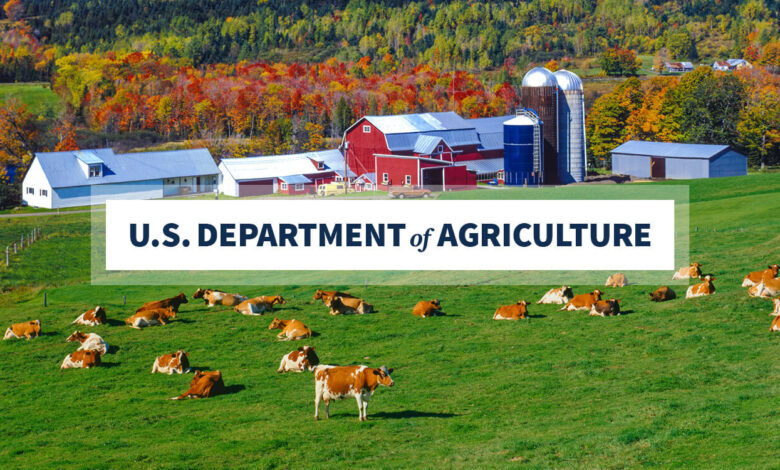USDA Announces Actions to Lower Food Prices, Bring Fairness to Farmers, and Promote More Competitive Food Supply Chains

Steps enhance research access to seeds to promote generic products, identify hidden fees and unfair pricing practices in beef sales markets, and set out options for transparency and fairer trading in cattle markets
WASHINGTON, October 08, 2024 — Today, the U.S. Department of Agriculture (USDA) announced multiple steps to deliver on the President’s Executive Order on Promoting Competition in the American Economy to promote fair and competitive markets for American farmers and ranchers, and lower food prices for American families. The following actions were announced by Agriculture Secretary Tom Vilsack during a Farmers and Ranchers in Action event hosted by the White House:
- First, through a multipart framework, USDA is leveraging its funding and research capacity, as well as interagency partnerships, to increase transparency and improve researcher access to seed germplasm, the starting materials plant breeders need to create diverse, resilient, and competitive seed varieties. These were key recommendations identified in USDA’s 2023 report, “More and Better Choices for Farmers: Promoting Fair Competition and Innovation in Seeds and Other Agricultural Inputs.”
- Second, USDA today published an interim report that assesses competitive conditions in the meat retail industry. The report draws on over 1,600 comments received from the public in response to USDA requests for information, interviews with small, medium, and large meatpackers, distributors, retailers, academics, and farmer or advocacy organizations. It identifies hidden fees and unjust/anticompetitive pricing strategies present in the beef market as a case study.
- Third, USDA announced the next steps in a new rulemaking effort under the Packers & Stockyards Act of 1921 to enhance price discovery and fairness in cattle markets. For years, USDA has fielded complaints from producers around beef packers using reported regional cash or spot prices as base prices for fed cattle formula pricing agreements, commonly known as Alternative Marketing Agreements (AMAs). USDA is issuing an Advanced Notice of Proposed Rulemaking (ANPR) to seek comment on several possible interventions to develop new benchmarks as AMA base prices and approaches to trading when using benchmarks.
“Over these last four years, the Biden-Harris Administration has made historic investments in agriculture to help farmers, small businesses, and rural communities get a fair shake,” said Secretary of Agriculture Tom Vilsack. “Our work on competition is about opening up new markets for farmers and delivering fairer, more competitive choices. Today’s actions will help to deliver on more choice and lower costs for seeds used by farmers, more choice and lower food costs for consumers, and a fairer marketplace for ranchers.”
“With today’s announcements, the Biden-Harris Administration is taking action to lower food prices for working families by enabling small businesses and family farms to compete fairly,” said National Economic Advisor Lael Brainard. “For too long, consolidation in the agriculture industry has been swallowing up family farms, lowering incomes and choices for farmers, and raising prices at the grocery store. Today’s announcements build on our work to restore fair competition in farming and food markets and to lower grocery prices for working families.”
“USDA is taking smart, strategic steps to open up pathways for continued innovation and improved competition in seed markets, new retail choices for small businesses and working family consumers alike, and fairer, more competitive trading in America’s world-leading cattle market,” said USDA’s Senior Advisor for Fair and Competitive Markets Andy Green. “These represent the first steps into these markets in a long time, and so we’re both listening to all while we’re doing so but we’re putting the relevant industries on notice that in the coming months, the USDA alongside its Federal partners will be amping up our scrutiny of these markets closely to protect fair, open, and honest competition.”
As President Biden outlined in the Competition Executive Order, consolidation in the agricultural industry is making it too hard for small family farms to survive as they face concentrated market power in the channels for selling agricultural products. In part due to the Administration’s efforts to tackle predatory pricing throughout the American economy, grocery inflation has improved as has certain key agricultural inputs such as fertilizer, but meat prices remain too high and competition in seeds markets remains highly constrained.
Seed Competition Framework
USDA’s framework for promoting research access to germplasm represents a three-part strategy for enhanced seed system diversity, competition, and resilience. Specifically, the framework:
- Identifies opportunities for better defining patent-related disclosure for seeds so researchers understand their freedom to operate. A letter from USDA to the U.S. Patent and Trademark Office (USPTO) USPTO describes the need for more clarity on breeding history and pedigrees and ensuring accessibility to seeds samples placed in patent depositories to adequately disclose plant-related inventions. Clarifying disclosure requirements for utility patents on seeds would help ensure researchers can better understand the scope and bounds of patent rights on plant-related inventions and conduct the research necessary to develop new innovations.
- Provides guidance to USDA researchers around observational uses of protected germplasm in the context of patent law. The ability to observe and understand patented inventions is necessary for federal scientists to pursue critical research and to innovate without fear of infringement. View USDA’s guidance for federal researchers (PDF, 201 KB).
- Encourages that germplasm developed by federal funding be shared for research and plant breeding, thus reflecting existing best practices. This will potentially help ensure that the germplasm pool is available for future innovation for both private and public breeders alike to bring new and diverse choices to the market. View USDA’s guidance for federally-funded research (PDF, 194 KB).
To learn more about USDA’s focus on seed competition, and to report a complaint, visit the Farmer Seed Liaison webpage.
Access to Retail Report
Released today, USDA’s interim report “Competition and Fair Practices in Meat Merchandising,” uses beef markets as a case study to better understand access to retail dynamics for producers and processors. USDA’s Agricultural Marketing Service (AMS) conducted an investigative study, took public comment, and supported academic examination of the topic.
This interim report has identified a trend of increasing market concentration nationally and regionally, particularly among the top four packers, distributors, and retailers. The report also highlights the views of commenters and interviewees, including farmers and small to midsize or independent packers and retailers, who describe their concerns with problematic practices by intermediaries.
As next steps, USDA will be continuing the investigative study already commenced, including through subpoenas. USDA is also announcing that the Agricultural Marketing Service will be commencing an Advanced Notice of Proposed Rulemaking in the coming months to seek public input around potential next steps.
Together, these efforts will protect free and fair competition on the merits for businesses operating in the retail channel; ensure that small, midsize, or independent businesses can continue to raise and process livestock; and help these businesses distribute and sell meat to the families and local communities that they serve.
Cattle Price Discovery Advanced Notice of Proposed Rulemaking (ANPR)
The Competition Executive Order directed USDA to address the unfair treatment of farmers and improve conditions of competition in the markets for their products through rulemaking actions under the Packers and Stockyards (P&S) Act. USDA was also directed to identify measures to enhance price discovery, increase transparency, and improve the functioning of the cattle and other livestock markets.
Upon publication in the Federal Register, AMS’s Packers and Stockyards Division will be seeking comment on a range of targeted options to improve price discovery and fair and competitive trading in fed cattle markets. The options presented in the ANPR focus on ways to ensure that the base prices in fed cattle purchasing agreements, commonly known as alternative marketing arrangements (AMAs), are representative of relevant market conditions and are not vulnerable to distortion or strategic behavior that could cause prices to shift for reasons other than changes in supply and demand.
These options are intended to mitigate the concern that AMAs have negative price effects on the spot market and otherwise distort the trading of fed cattle, which are complaints that AMS has received over the years. Cattle plays an important role in the economic health of many rural communities, and so fairness to cattle producers is vitally important.
View a preview of the ANPR.
For more information on USDA’s competition efforts visit the Fair and Competitive Markets webpage.
USDA touches the lives of all Americans each day in so many positive ways. In the Biden-Harris Administration, USDA is transforming America’s food system with a greater focus on more resilient local and regional food production, fairer markets for all producers, ensuring access to safe, healthy, and nutritious food in all communities, building new markets and streams of income for farmers and producers using climate smart food and forestry practices, making historic investments in infrastructure and clean energy capabilities in rural America, and committing to equity across the Department by removing systemic barriers and building a workforce more representative of America. To learn more, visit www.usda.gov.
#
USDA is an equal opportunity provider, employer, and lender.


